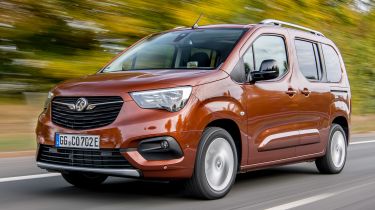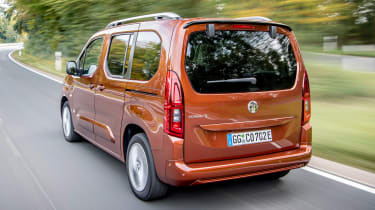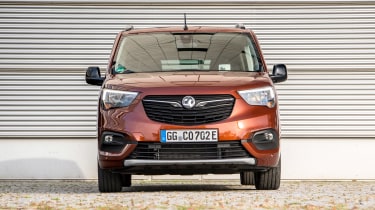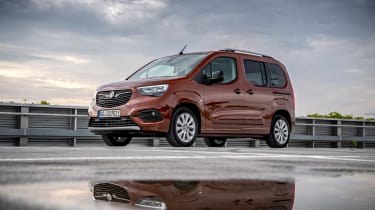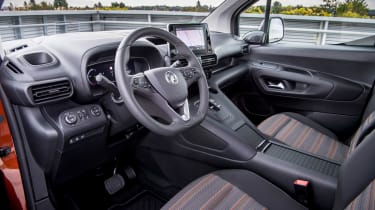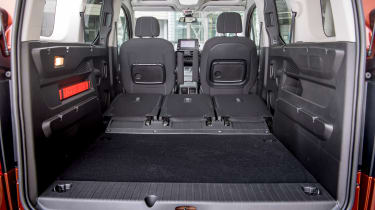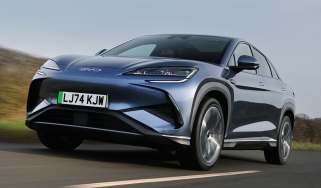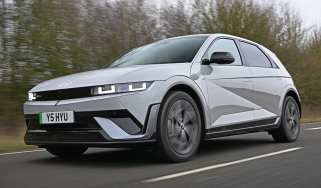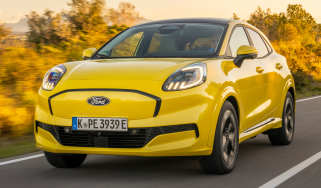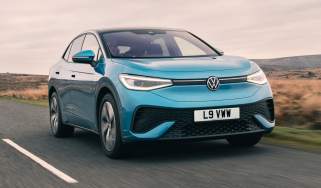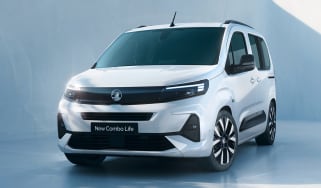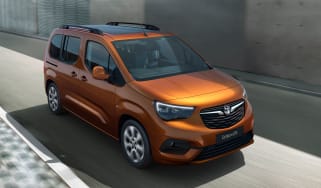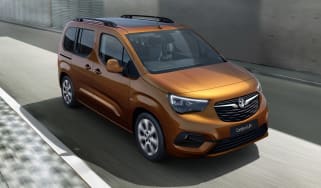Vauxhall Combo-e Life MPV review
"The Vauxhall Combo-e Life is an electric 'van with windows' that offers a hard-to-beat combination of value and versatility"
Pros
- Seriously versatile
- Great value for money
- Respectable range
Cons
- Wind noise
- Gawky looks
- Wallowy handling
The Vauxhall Combo Life looks unassuming but it’s a significant vehicle for the brand, given that it’s now offered only with an electric powertrain and is Vauxhall’s entry-level seven-seater. Now called the Combo-e Life, this van-based people-carrier shares several parts with the Citroen e-Berlingo and Peugeot e-Rifter, which are now only available as EVs.
This is no bad thing: as the Combo-e Life, e-Berlingo and e-Rifter were all designed as commercial vehicles from the ground up, meaning that despite the switch to pure-electric power, all are still very practical, no-nonsense machines that can handle the rigours of family life. Indeed, Vauxhall's decision to name its family-size workhorse the 'Combo-e Life' precisely sums up what this boxy machine is all about.
 The best 7-seater cars to buy in 2025
The best 7-seater cars to buy in 2025
The Vauxhall Combo-e Life fills the space left in the range by the Vauxhall Zafira Tourer, the brand’s previous full-size MPV. Combo-e Life buyers can choose between two body lengths and either five or seven seats, with the Combo-e Life XL offering a massive 2,700 litres of luggage space when all the seats are folded out of use.
The Combo-e Life doesn't seem to have been styled with quite the same flair as its Peugeot and Citroen sister models; it’s a no-nonsense design that makes no attempt to hide its commercial origins. The Citroen's split-headlamp design and SUV-flavoured Peugeot are both more distinctive than the Vauxhall, which looks rather apologetic by comparison. The common-sense theme continues with the electric powertrain, which is identical across all three models.
Claimed range is up to 174 miles on a full charge with a single electric motor powering the front wheels. This powertrain produces 134bhp, making it more powerful than the discontinued petrol and diesel models. While it is now more expensive to buy, the switch to pure-electric power means it will be cheap to run if you can regularly charge it at home. Topping up the battery on longer journeys should also be a straightforward task too, with a charge from 10-80% taking around 30 minutes when using a 100kWh rapid-charger.
As part of the 2022 update, the Combo-e is now only available in SE trim. It’s well specced, with an eight-inch infotainment touchscreen with Apple CarPlay and Android Auto, a DAB radio, alloy wheels, cruise control, a rear-view camera, rear parking sensors, forward collision alert and tinted rear windows.
Vauxhall appears to have judged the specification of the Combo-e Life quite cleverly; the model occupies a narrow slot between the similarly priced e-Berlingo and the more plush, SUV-styled e-Rifter. For many families, the Vauxhall could strike the perfect balance of practicality, comfort and cost.
Range, charging & running costs
As part of an update introduced in early 2022, the Combo-e Life is now only available with an electric powertrain. Despite this switch, Vauxhall claims it's cheaper to run than the discontinued petrol and diesel models.
Under the floor is a 50kWh battery pack that’s shared with the e-Berlingo and e-Rifter sister models, offering a range of around 174 miles on a charge. This figure might seem to fall short of the old petrol and diesel powered models, which could comfortably manage nearly double this distance, so to help maximise the usability of the Combo-e Life, Vauxhall has fitted 100kW rapid-charging capability. This means that a quick 30-minute charging stop will top up the battery from 10-80%, making longer journeys easier.
Buyers that can recharge at home may only pay a few pounds for a full charge and servicing should be cheaper, too, and while the electric model is slightly more expensive to buy when compared to the old petrol and diesel models, both private and business users stand to save money, with tiny BiK tax payments for company-car drivers and free VED (road tax), along with exemption from both the ULEZ and London Congestion Charge Zone..
Even the old diesel version costs far more to run than the electric Combo-e Life. Both private and business users stand to save money, with tiny BiK tax payments for company-car drivers and free VED (road tax). Buyers that can recharge at home may only pay a few pounds for a full charge and servicing should be cheaper.
The Combo-e Life's commercial-van origins mean other running costs are unlikely to break the bank, with reasonable servicing costs and consumables such as tyres and brakes being sensibly priced. Every new Vauxhall carries a three-year/60,000-mile warranty, and the Citroen e-Berlingo and its relatives have established a good reputation for reliability, which the Vauxhall Combo-e Life has no excuse not to follow.
When it comes to servicing, the Combo-e Life needs an inspection after the first year or 12,500 miles, but from then on it only needs to be serviced every two years or 25,000 miles.
When the regular combustion engines were available, the 1.2-litre petrol was the cheapest to buy. In 109bhp specification, it can return up to 44.1mpg, with a CO2 emissions figure of 145g/km.
If you plan to cover more than 12,000 miles a year, the discontinued diesel engine could be worth considering. The base 99bhp version was the most economical, managing up to 53mpg, while the 128bhp version returns around 50mpg. CO2 emissions for this engine start from around 135g/km.
Electric motor, drive & performance
Sharing its electric powertrain and battery with the Peugeot e-Rifter and Citroen e-Berlingo, the Vauxhall Combo-e Life offers similar performance. The electric motor has 134bhp, getting it from 0-62mph in 11.7 seconds. So while it won’t be pushing you back into your seat as you accelerate away from a standstill, it’s still capable enough thanks to the instant power delivery from the electric motor.
Those moving to the Combo-e Life from a regular estate car or MPV might need to adopt a more relaxed driving style, because due to its van-based origins, it’s not particularly sharp to drive. The steering feels precise and initial cornering turn-in is remarkably eager, thanks in part to front suspension that's closely related to the Peugeot 3008.
However, in pursuit of load-carrying capacity, the Combo-e Life, e-Berlingo and e-Rifter use a very simple rear suspension system and the body can lurch and lean in corners as a result. It's far more comfortable when you take it easy, and rides smoothly over all but the most severe potholes. Meanwhile, being relatively narrow for its height, the Combo-e Life proves easy to position on tight urban roads, while the large glass area aids visibility when manoeuvring.
The Combo-e Life has three mode settings: Power (the full 134bhp), Normal (107bhp) and the Eco setting that pegs you back to around 80bhp. Body roll is well contained because the location of the battery gives a low centre of gravity, so it’s actually a little better to drive than petrol and diesel models. It’s quieter too.
Before the combustion engines were discontinued, the 109bhp 1.2-litre petrol was our pick of the regular Combo Life range. For the five-seat model, this engine proved to be a capable performer, making it pleasant to drive. However, the 1.5-litre BlueHDi diesel is a better choice if you plan to pick a seven-seat model, as it's extra pulling power makes it feel less strained with seven people onboard.
Interior & comfort
The rounded oblong shape of the Vauxhall Combo-e Life spells both good news and bad news for comfort. The main downside is lots of wind noise, due to the less-than-streamlined way the car hacks its way through the air. The other is that occupants are forced to sit in a rather upright fashion – passengers can't recline and stretch out like they might in a saloon.
Allow for these shortfalls, though, and the Combo-e Life is an agreeable way for a family to travel. Inside, the passenger environment feels a little more tactile and is more pleasing to look at than the Citroen e-Berlingo's interior, but doesn't exhibit the extra SUV-inspired design touches of the Peugeot e-Rifter.
As part of the 2022 update, the Combo-e Life is now only available in SE trim. This specification elevates the model a little further from its commercial origins by adding 16-inch alloy wheels, rear parking sensors and cruise control with a speed limiter. Inside, the dashboard materials are improved, along with an eight-inch infotainment touchscreen and a DAB radio.
While the infotainment system is proven, being essentially a subtly redesigned version of that used by the Vauxhall's Peugeot and Citroen sisters, we recommend against paying to add sat nav. With Apple CarPlay and Android Auto compatibility built in as standard, you're better off using your smartphone's navigation system if you have enough data.
Practicality & boot space
Versatility really is the be-all and end-all of cars like the Vauxhall Combo, and families will love the practicality of its load space and many seating permutations. Even when every seat is occupied, it's unlikely that anybody will complain of a lack of space, and each seat in the second row is ISOFIX-equipped, making it possible to carry three child seats.
Even the regular-wheelbase Combo-e Life offers a huge boot, with 597 litres of load volume, or 2,126 with the passenger seats folded out of use. In five-seat examples, the second row is 60:40 split, but seven-seat Combos have individually folding rear seats, which opens up even more versatility – especially if you order the Family Pack, which allows the front passenger seat to fold flat, allowing 2.7-metre long loads to be accommodated. These figures are unchanged for the electric Combo-e version.
The standard-wheelbase model sacrifices quite a lot of boot space in seven-seat mode, but those who frequently need to carry a full complement of passengers and their belongings can go for the Combo-e Life XL. Its extra length brings a total load volume of 2,700 litres when all the passenger seats are folded out of the way.
Up front, interior storage hasn't been forgotten – there are deep door bins and cubbyholes scattered around the dashboard. Compared to the Peugeot Rifter, though, there's a surprising absence of clever storage solutions. You need to visit the options list to find roof storage and aircraft-style overhead lockers.
Reliability & safety
The Vauxhall Combo-e Life betrays its commercial roots by lacking some of the driver-assistance features that many have come to expect in today's family cars. A forward-collision-alert system is standard, as is a rear-view camera.
Optional driver aids extend to an Intelligrip system to increase off-road traction in conjunction with all-weather tyres. The regular Combo Life has been crash-tested by Euro NCAP and awarded four stars out of five. Its 91% score for adult occupant protection impressed, along with 81% for child occupants. A tall bonnet, stiff windscreen pillars and an autonomous emergency braking system unable to detect cyclists held it back in the vulnerable road users category.
Nor have any of the three yet been included in our annual Driver Power owner satisfaction survey. However, every mechanical aspect of the Combo-e’s design has been well proven and the Stellantis group has a reputation for producing hard-worked commercial vehicles that owners can rely on. It's possible, though, that Vauxhall owners might have differing experiences of dealers compared to Peugeot and Citroen drivers.

